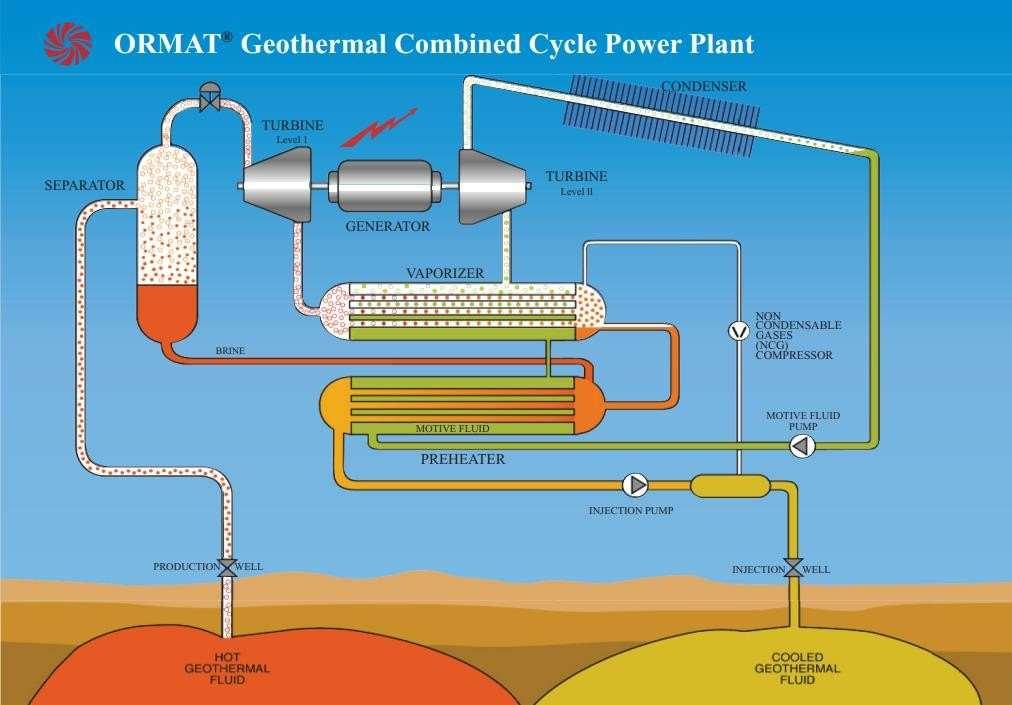GEOTHERMAL ENERGY SERIES O&G Expertise Unlocking the Earth’s Energy Potential: Part 2
Tim Monachello, CFA, Analyst, Managing Director, ATB Capital Markets
Patrick Tang, CFA, CPA, Associate, ATB Capital Markets
ABOUT GEOTHERMAL

Geothermal energy is ubiquitous around the globe; it is generated from the decay of radioactive isotopes in the Earth’s core, creating temperatures in excess of 5,000°C. This heat radiates through the mantle to the Earth’s crust where it can be harnessed for generating electricity or used directly for heating. The aggregate amount of energy from geothermal sources is estimated to be 50,000 times the total energy from oil and coal reserves globally (International Renewable Energy Agency, 2017).
Until now, the substantial majority of geothermal development has been in the form of wells drilled into underground formations that produce heated brine (water present in the reservoir), which can then be used to produce electricity using heat-to-power technologies, with lowgrade or residual heat utilized for direct use heating applications. While not a focus of this report, geothermal energy is also used in ‘heat-pump’ applications, which circulate fluid in a shallow closed loop to harness geothermal heat or facilitate cooling in smaller-scale applications.
“Geothermal energy has significant advantages over other forms of power. Most importantly, geothermal can be reliably used as a source of renewable baseload electricity.”
Geothermal energy has significant advantages over other forms of power. Most importantly, geothermal can be reliably used as a source of renewable baseload electricity. Its capacity factor is above all other renewable sources, meaning it can consistently meet demand on the grid without any major intermittency. For certain designs, geothermal can also be loadfollowing if geothermal flows are halted when other renewables are generating, and restarted after absorbing more thermal energy when other renewables are offline. Moreover, geothermal plants are generally more productive in the winter when wind and solar are disrupted more frequently, making geothermal a suitable complement to these other technologies. Beyond this, geothermal also produces no meaningful emissions and often has a small surface footprint with minimal environmental disruption beyond the construction phase. Regarding these latter points on footprint and disruption, these are often criticisms of wind, solar, and hydro development that can be a damper on land negotiations, which can often delay or halt development altogether. Also, geothermal does not produce waste beyond initial construction, which is an advantage over nuclear power plants.
“… geothermal developments have been sparse over recent decades, largely because projects with conventional geothermal technologies have only been proven to be economic in regions where there are naturally high temperature geothermal resources at relatively low depths …”

While the advantages of geothermal are promising, geothermal developments have been sparse over recent decades, largely because projects with conventional geothermal technologies have only been proven to be economic in regions where there are naturally high temperature geothermal resources at relatively low depths – these tend to be near volcanically active regions or in regions near tectonic plate boundaries. That said, enhanced geothermal systems (EGS) are being developed that could ultimately improve the economics of lower temperature resources, which could significantly increase the viability of geothermal developments around the globe.

Geothermal Innovation Could Unlock the “Holy Grail” of Renewable Resources
Figure 5 – Geothermal Innovation Could Unlock the “Holy Grail” of Renewable Resources Source: US Department of Energy, ATB Capital Markets Inc.
Conventional Geothermal Systems (Hydrothermal): Geothermal developments have historically focused on known hydrothermal reservoirs. The scarcity of these resources has limited geothermal development.
Conventional Systems are Being Enriched: While not shown in the figure, conventional hydrothermal projects are finding new ways to improve returns, through supplementary revenue streams and carbon pricing mechanisms. These revenue enhancements are reducing the resource quality constraints for projects, thereby making lower temperature resource areas feasible.
Enhanced Geothermal Systems; Deeper, Hotter, Dryer, Cheaper: New technologies are being developed that could significantly improve the economic viability of geothermal power generation outside of conventional hydrothermal resource areas. These innovations are generally looking to 1) cost effectively drill geothermal wells deeper where higher temperatures are present, 2) improve reservoir characteristics for hot rock resources where geology doesn’t support sufficient flow for conventional geothermal power generation, and 3) remove the requirement to produce and inject reservoir water all together (closed-loop).
Step Change Technologies: Dubbed as the ‘holy grail’ of geothermal innovations is the ability to drill ultra-deep into the Earth’s crust. At vertical depths greater than roughly 7 km, geothermal temperatures are generally in the 120-200°C range, hot enough to justify commercial development. At depths 10-20 km, temperatures across the globe are generally in the 200-400°C range, hot enough to make geothermal power generation widely commercially competitive with current sources of energy, both renewable and nonrenewable.
Geothermal Power Generation
For electricity generation, the majority of geothermal power plants have significant similarities. Most designs rely on produced brine from an underground aquifer. This liquid is brought to the surface, where heat and temperature are controlled to drive a phase change to gas, either directly from the liquid brine or from the liquid phase of a working fluid in a binary cycle design (using a heat exchanger). The expansion of the fluid provides mechanical energy for turning a turbine. After the produced brine is no longer at high enough temperatures for power generation, it is pumped back into the ground through an injection well, which exerts a parasitic load on the system as the pumps draw power. Dry steam plants, which are less common today, are different in that the produced fluid is generally a ready-use steam that can be directly passed through the turbine and released to the atmosphere, with no associated parasitic load. Geothermal heat is most commonly utilized in dry steam power plants, flash steam power plants, or binary cycle power plants.






